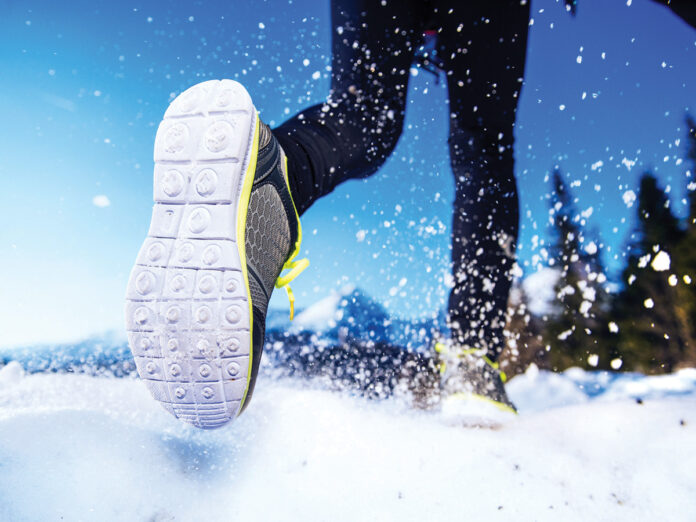
If you’re a year-round runner braving icy streets and snowy pathways, getting the right footwear is paramount. But which running shoe will serve you best through the winter season depends on where you live and the conditions you expect to run in. If clear roads and trails free of snow and ice are not available, and traction and waterproofing are weighing on your thoughts, then here are a few tips to consider.
1. Waterproofing
In snowy conditions, especially on a warmer day with melting snow and ice, some level of water repellency can be beneficial and make your feet more comfortable. First, the shoe upper can be made with a membrane or coated in a substance that will repel water from the outside. And second, the lacing system and tongue can be designed in a way that helps keep snow and water from getting in over the shoe. For example, you might consider a Gore-Tex™ upper and a fully integrated tongue with a draw-cord style, fast lacing system.
2. Stability
One area that tends to get overlooked with winter running shoes is the level of stability they promote around the feet and ankles. Running in snow, particularly deeper snow, will often feel like running on a wobbly and uneven surface with the potential to suddenly increase the inward or outward roll of the ankle with any given step.
Creating more stability doesn’t need to be as dramatic as adding special insoles, it can be as simple as choosing a shoe with a stiffer and more supportive upper around the ankle area. Ensuring that the top of the lacing system really allows you to cinch in the upper around the top of the instep of the foot can also help.
3. Traction
The most obvious factor to consider when choosing winter running shoes is how much grip they offer. A conservative approach would be to opt for an aggressive, hardcore, trail-style pattern on the outsole. For deep fluffy snow, or mud and snow, this may work. However for true grip even on compacted snow or ice, some kind of micro spike system will provide the best peace of mind. These micro spikes can either be built into the outsole by the manufacturer, screwed into the sole by the user or pulled over the soles with a separate, rubber traction device.
If you don’t want to mess with a separate piece of kit, then a purpose-built shoe with integrated spikes is the way to go. If these models don’t suit you then adding ‘hobnail’ spikes to your existing shoes could be best. And finally if the integrated brands don’t do it for you and you’re not into adding your own spikes, then over-the-shoe rubber-mounted spikes are probably your best option.
So don’t let snowy or icy conditions deter you from a bracing outdoor run. With the right shoes on your feet you can kick winter right to the curb.















